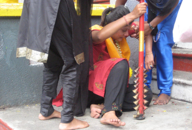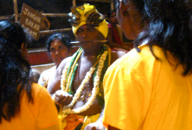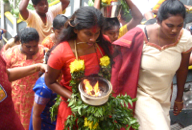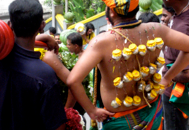THAIPUSAM
SPECTACLE OF KAVADI CARRIERS
batu TEMPLE cave
kuala lumpur, state of selangor, malaysia
february 1, 2009


THAIPUSAM
SPECTACLE OF KAVADI CARRIERS
batu TEMPLE cave
kuala lumpur, state of selangor, malaysia
february 1, 2009




Thaipusam seemed to have begun a week early this year. This Hindu spectacle, the most popular festival in Malaysia, was slated to begin on Sunday, February 8th. However, on Sunday, February 1st, when Henry and I chose to visit the site of this event, Batu Cave Temple, we were surprised to find a large number of devotees already enacting a public, yet personal ritual, which had been described to us as somewhat masochistic. The main event is famous world-wide, and attracting an annual crowd numbering into the hundreds of thousands. We were fortunate to have had an opportunity to “preview” this event. With surprise, shock, and awe, Henry and I witnessed amazing expressions of devotion, while fortunately remaining free of the crush of massive the crowds which would convene here the following weekend. It was a photographers dream, to be able to capture this unique ceremony, the colorful array of costumes, and the solidarity of friends and family in support of a kavadi carrier, fulfilling a pledge made in gratitude. As I understand it, and at first it seemed incomprehensible, the devotees who perform kavadi on Thaipusam, have made a pledge of self denial, and have chosen a particular form of abstinence and self discipline to fulfill that pledge. Carrying the kavadi can vary. Entire families carried gifts to the temple together. Couples whose prayers for a child had been answered, could be seen transporting their baby to the temple, carried in a sling tied to three sugar cane poles, each end supported by a parent. I have spoken to two men who have participated in Thaipusam: one, a staff member of the Mandarin Oriental in Kuala Lumpur, and another, a lawyer living in Singapore. The lawyer has participated in Thaipusam each year for ten years. He told me that he ate only vegetarian food for 48 days, prayed and meditated, abstained from acts of comfort, shaved his head, dressed in devotional attire, and carried a pail of milk on his head to the temple. The Mandarin Oriental staff member told me the story of his promise to be a kavadi carrier. He told me that a few years ago, his sister was injured and hospitalized after a construction truck hit her while she was crossing a street. She was in a coma, and paralyzed. The doctors had no hope for her recovery. Her entire family gathered around and prayed for her. Her brother promised that he would carry the kavadi for three years in a row, if she would only recover her health and mobility. Miraculously, she did; and, he has fulfilled his promise. Every year for three years, he has followed the 48 day ritual of fasting by eating only vegetarian food, praying, meditating, sleeping on the floor, shaving his head, dressing in devotional clothes. He has also gone the next step: he has had his body pierced with hooks, each of which bore a rose. Ropes were also attached to the hooks. Surrounded by friends and family who offered their prayers, encouragement and support, he walked the 272 steps to the temple. Some kavadi carriers go to even further extremes, attaching themselves to umbrella-shaped cages of metal, carrying great burdens, piercing the body with knives or swords, walking on hot coals, etc. etc. This ritual is in thanksgiving. It is a promise made to the higher power. It calls upon the higher power to give courage and spiritual strength to the devotee. I was personally stunned when I saw the first kavadi carrier, his back pierced with hooks and ropes. I couldn’t understand the significance, the purpose, or the ritual. After speaking to others about this, I have begun to understand the expression of faith, and of the discipline of mind over matter. The amazing result of the piercing of cheeks, lips, tongues, and skin on the torso is this: the instruments of piercing do not leave scars. The ritual of Thaipusam is so inwardly intense and so energetically attuned that (I am told) none of the forms of self-infliction does harm or hurts. The devotees have prepared themselves for this, otherwise they could not endure the pain. I was also told that those who assist in threading the hooks are seasoned experts, knowing exactly how to apply the piercing. After the ceremony is complete and the instruments of infliction have been removed, lime juice and ashes are applied to the body to soothe and heal the skin, causing no scarring. Even though I understand the underlying significance of this exhibition of faith, I had no interest in seeing more demonstrations, including the Thaipusam spectacle which took place in Singapore while we were there. Thaipusam has been outlawed in India. In Kuala Lumpur, Malaysia, thousands of local as well as international devotees and curiosity seekers converged on Batu Cave Temple this year to participate in this ritual, or simply to bear witness to the extraordinary and dramatic fulfillment of promises to the divine.
PHOTOS: Left Column: 1. A family, each member dressed in yellow and white, participating in Thaipusam by carrying pails of milk to the temple. 2. A Kavadi Carrier, having reached his goal, undergoing more rituals to fulfill his promise. He is surrounded by family and supporters all interacting with another participant and his entourage. Some of the women, his wife and mother, also participated in a dance accompanied by drums, the women enacting the energy of Kali, the goddess of destruction, by revealing their red tongues. 3. A young woman devotee, being helped to her feet as she climbs the 272 steep steps to the temple. 4. A beautiful woman Kavadi Carrier, surrounded by an entourage of women, carrying a pot burning with fire as she ascended the 272 steps. A cushion of green leaves helped protect her hands from the heat. 5. A Kavadi Carrier, dressed in yellow and bedecked with garlands, head shaved and painted with turmeric, a triton (symbolic of Lord Munugan) piercing his cheek, carrying a pot of milk on his head as he walks upward toward the temple. 6. A Kavadi Carrier, his back pierced with hooks holding heavy chains, supporting himself with a triton, ascending the 272 steps toward Batu Cave Temple. Center, Top: Someone special -- not a Kavadi Carrier, more like a shaman. He was surrounded by a group of musicians, had an umbrella trimmed with fringe. He was dressed in finery which included many esoteric symbols. Center, Middle: A very fit Kavadi Carrier ascending the 272 steps, two steps at a time. He is dressed in silk and gold, has a beautiful arrangement of hooks on his back and chest supporting limes which just happen to be color coordinated with his attire. Though he appears to be alone, he has a couple friends trailing behind in support. Center, Bottom: A little girl carrying a milk pail, having arrived at the temple with her mother and aunt. Right Column: 1. Women Kavadi Carriers wearing bright colored saris ascending the steep steps to Batu Cave Temple. 2. A Kavadi Carrier, having arrived at the temple, hooks and ropes in his back, undergoing more ritual, dancing and other ceremonies. 3. A group of young women being blessed by a priest/shaman, a triton piercing his cheeks. 4. A highly decorated structure, being carried up the 272 steps by a Kavadi Carrier. This heavy burden required that he take frequent breaks by sitting on a stool A whole army of people seemed to be helping him fulfill his promise. 5. A couple, carrying their baby in a sling supported by three sugar cane poles, is about to mount the first step on their journey toward the temple. Note the baby’s feet! 6. A Kavadi Carrier, turned to look downward, obviously waiting for someone. His supporter is carrying a large red weight. He is dressed in silk attire and has what appear to be lightweight paper objects hanging from the hooks in his back.


THE DEVOTEES .... THE PEOPLE!











